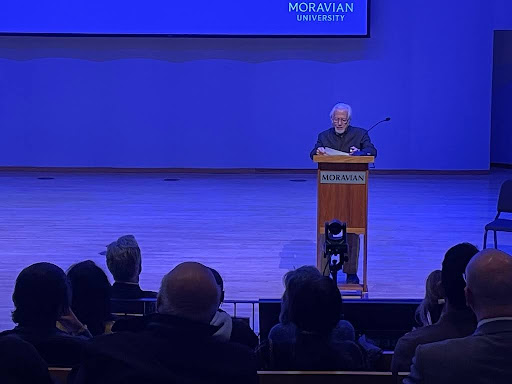During some cleanup after faculty turnover last year, the staff and faculty in Moravian’s Art Department raised concerns about a real human skeleton that art students had been using as a reference.
As a consequence, the department decided to remove the skeleton from circulation and place it in storage. Moravian’s Biology Department will now investigate the skeleton’s origins.
Camille Murphy, the department chair of the Art Department, only learned of the skeleton’s existence last year.
“For me, it brings up questions of its origin– there are no records that accompany it,” she said.
The skeleton was acquired in the 1980s, primarily for use in life drawing courses, a common practice of art departments. Moravian’s Art Department now relies on manufactured skeletons for courses.
The skeleton is currently located on South Campus in a special cabinet that was ordered a couple of years ago to safely house it. There is a “skeleton key” to the cabinet that is kept in a secure location.
Although the source of Moravian’s skeleton is unknown, most teaching skeletons originate from India and are of South Asian ethnicity. Starting in the mid-1800s, a shady yet legal practice of selling human remains became a lucrative business. The victims of this trade were often extremely poor, and their bones were sold after their deaths.
One of the main suppliers of these remains was India during the time of British colonialism.“Bone brokers,” or lower-caste people who were employed to dispose of the dead, smuggled the bones that were supposed to be cremated overseas to medical colleges for anatomical study.
These remains were often legally sold to universities for profit, and the trade continued for decades past their independence until the export of human remains was banned in 1985.
According to an NPR interview with Scott Carney, an expert on India’s bone trading practices, “Calcutta was exporting about 60,000 human skeletons every year.”
These inquiries raise important discussions regarding the ethics of using human skeletons as teaching tools.
A school in Liverpool, England, decided to lay their teaching skeleton to rest after discovering its origins. Despite being used as a teaching tool for over 40 years, the faculty and students determined that “Arthur,” as they had nicknamed him, should be buried. Like many other teaching skeletons, this one had been tested and confirmed to be of a South Asian individual, who was most likely a victim of the lucrative bone trade in the early 1900s.
Many anthropologists believe the victims of the bone trade are victims of scientific racism, in which certain racial and ethnic groups were more likely to be experimented on, or in this case, used as specimens to be studied rather than viewed as human bodies that deserve their privacy and sanctity.
Additionally, many cultures and religions place a high emphasis on proper burial practices in order for the souls of the dead to achieve salvation, raising further ethical questions.
However, the practice of using human skeletons has not ceased. After the 1985 Philadelphia Police bombings of the MOVE organization that killed numerous black children, for example, an Ivy League professor employed their bones in a “case study” in an online forensic anthropology course. The University of Pennsylvania and Princeton University temporarily were in charge of these children’s bones, which were never returned to the family or properly buried.








Jessie pink man • Oct 16, 2023 at 5:45 pm
Very interesting article. Keep up the great wrok